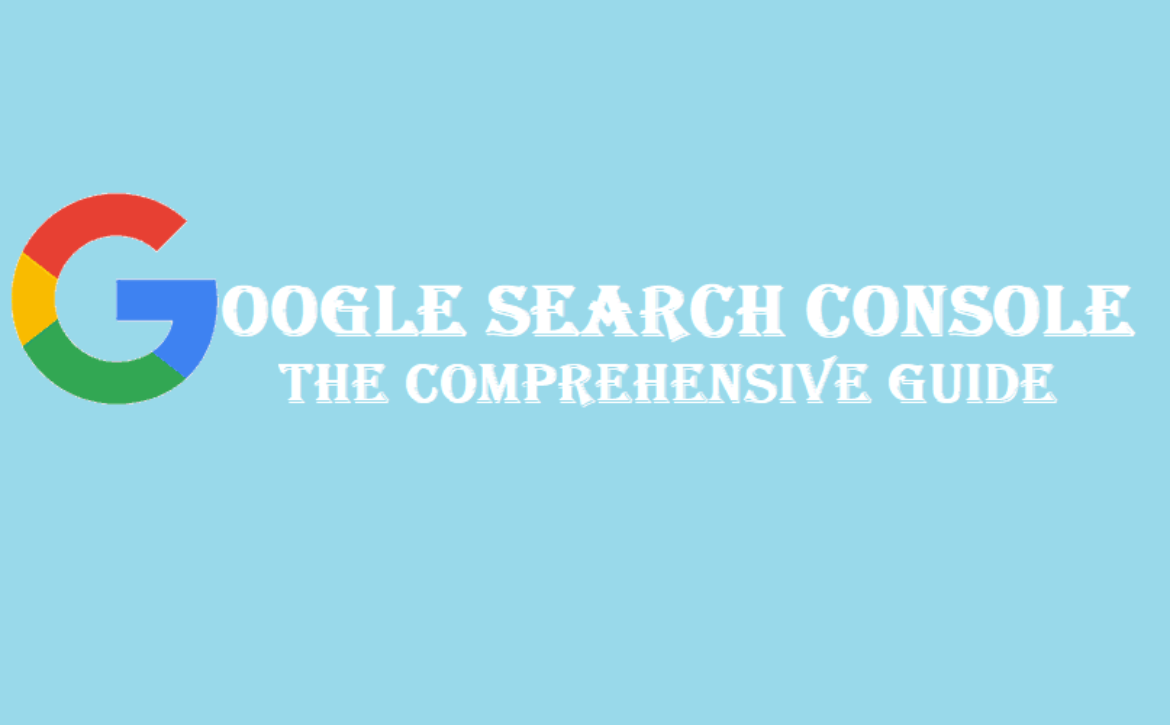Google Search Console: The Comprehensive Guide
Google Search Console recently came into existence, and many people still need to learn what it is and how to use it. Google Search Console is the tool that all webmasters need for effective SEO. With this software, you’ll be able to see how your website performs in search engines and whether or not your site is up-to-date. Google created this tool to help webmasters test their sites, but more than that, it’s also a chance for Google to improve the overall search algorithm and make sure sites are appropriately indexed.
What is Google Search Console?
——————————
As briefly explained in the intro section, Google Search Console is a tool that will allow users to test their sites by seeing how they appear in all the major search engines like Google, Yahoo, Bing, and Ask. It’s all completely free, and the only condition is that you must have a Google Adsense account. Once you’ve created an account, you will be sent various emails and messages to remind you of these services.
To use this tool, you first need to install it on your PC, or if you’re using a Mac, you’ll need to download the application. There will be some simple instructions included where they explain how things work. You’ll need to sign in with your Google account, and you’ll be able to see how your site is presented on Google.com.
Google Search Console is a free tool that will allow you to see what your website has indexed, crawl your site for indexing, and suggest and analyze crawl errors. It will also show you data about search engine visits to your website. These areas’ results can help determine how effective you are at SEO.
This blog post provides a general introduction to Google Search Console. I only focus on the main parts of the Google Search Console. For more information about Google Search Console, please see the official documentation. You can also use Webmaster Tools Help for extra help with Google Search Console.
Indexing
——————————
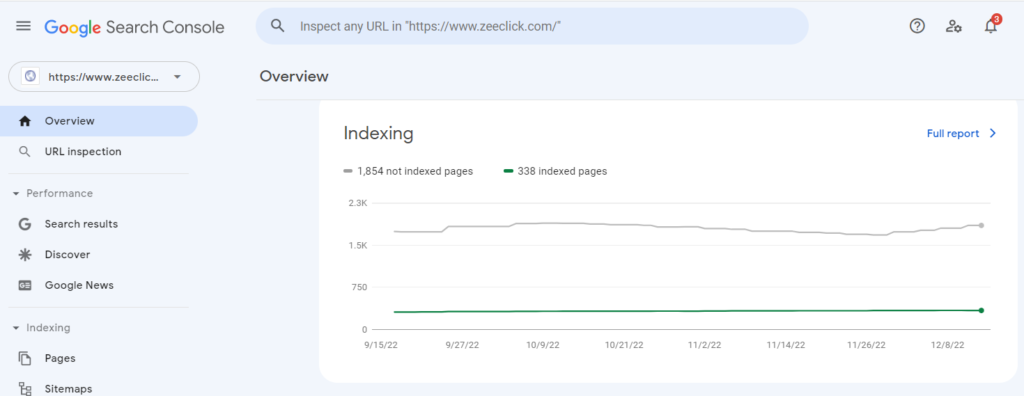 Google Search Console displays how many pages your website has indexed in Google search results. This is a good indication of how many pages from your site are being crawled by Google. To get this information, follow the mentioned steps below.
Google Search Console displays how many pages your website has indexed in Google search results. This is a good indication of how many pages from your site are being crawled by Google. To get this information, follow the mentioned steps below.
- Go to your Google Search Console.
- Click Basic information > Webmaster Tools.
- Click View > Crawl errors report. You can also click View > Indexed URL report, which will give you similar information about all the pages in Google’s index, with links pointing to these pages.
- Click on the Indexed URLs tab in the Report Options window.
- Click on the Date Range drop-down menu, and select All Time.
- Under the Crawl Errors tab, click on the Top 100 URLs by errors to see errors that Google has found when crawling your website. You will also see how many pages have been indexed for each URL. If a URL does not have any data, this does not necessarily mean that Google is having trouble with your website or indexing it.
What are the benefits of Google Search Console?
——————————
Much has changed since Google was just a search engine, and it’s now a significant part of many people’s lives.
And if you’re using Google Search Console to manage your website, you are in for some benefits. It helps you monitor how search engines like Google view your site and offers insights into how to tweak things for better results.
It provides detailed reports about the number of impressions and clicks on individual pages, discrepancies between what happens on different devices, the position of your site in search results, and more.
As an SEO tool, Search Console helps boost your site’s performance. We drew on our experience managing over a million websites to select the most valuable features.
Search Console is part of Google Webmaster Tools, which has been around since 2005. As the name implies, Webmaster Tools assists webmasters with site management and maintenance via free tools like PageSpeed Insights, Analytics, and more.
But Search Console is a much more recent addition and, for many, the most important. It includes a whole range of information about your site, content, and performance, not just in search results but also in Google’s Knowledge Graph.
In this article, we examine each of Search Console’s features, so you can understand what they mean and what they reveal.
How to manage your website with Google Search Console?
——————————
For websites of all kinds, but particularly for those that represent brands and enterprises, Google Search Console (GSC) is a goldmine of data. It can assist you in determining the search phrases people use to locate your website and analyze crucial data like clicks, impressions, and your average position in Google search.
Additionally, you may use GSC to work through technical difficulties to ensure that your pages are correctly indexed and available to searchers. When it finds problems with your site, GSC will even send you email alerts, and you may let Google know once the issues have been resolved.
The features mentioned earlier are merely the fundamentals, but they are all vital components of keeping your site up to date so that it may continue to promote your company or brand. GSC can assist you with many more things, but you must first configure it for your website.
Adding Your Website to Google Search Console: Steps
——————————
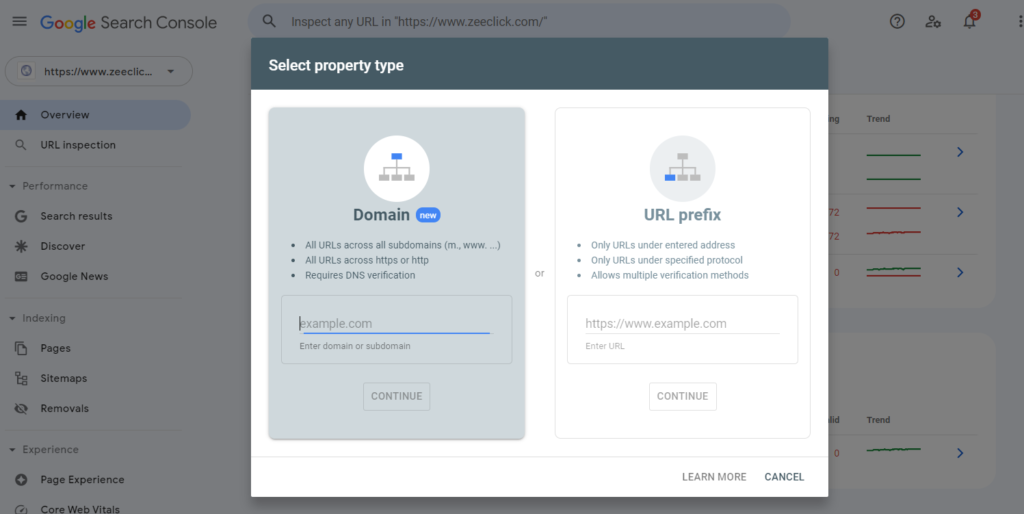
- Enter your Google account information. If it is a business website, be sure you’re logging in with your business (and not personal) account.
- Visiting Google Webmaster Tools
- To add a property, click.
- Select “Website” from the drop-down option, then type the website’s URL. The URL that shows in the browser bar must be used precisely.
- To continue, click.
- Choose a method to prove your website is yours (HTML file upload, domain name provider, HTML tag, GA tracking code, or GTM container snippet).
- If your website is compatible with HTTP and HTTPS, add each separately. Each domain must be added (for example, zeeclick.com, blog.zeeclick.com, and www.zeeclick.com).
Even before it has been confirmed that you are the site owner, Google starts recording data for your property as soon as you submit it to GSC.
Making Your Website GSC Verified
——————————
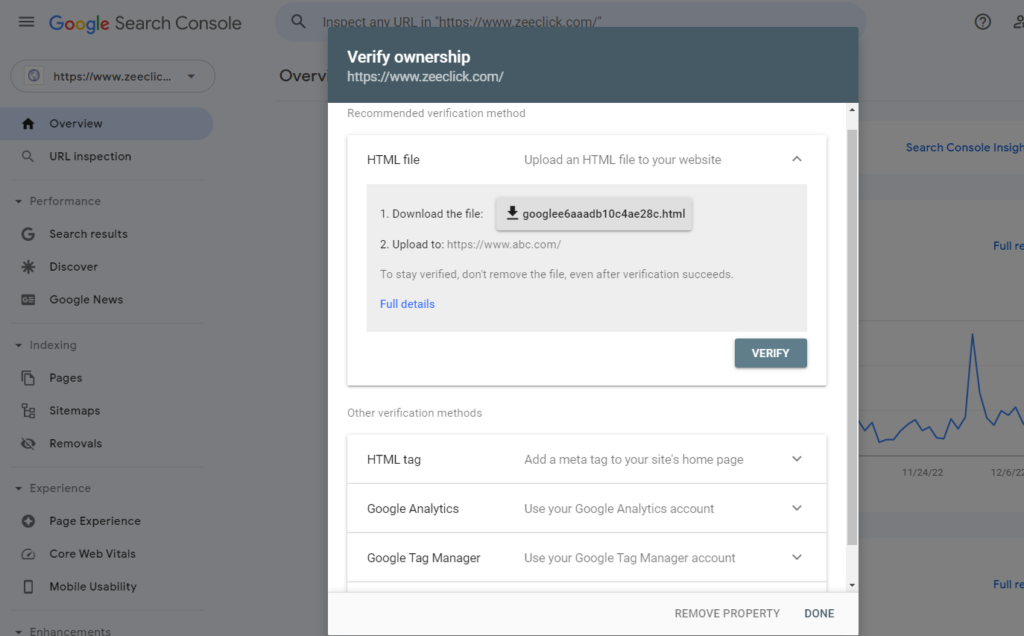 Because GSC allows you access to private data about a site’s or app’s performance and control over how Google crawls that site or app, you must prove you are the rightful owner of that site or app.
Because GSC allows you access to private data about a site’s or app’s performance and control over how Google crawls that site or app, you must prove you are the rightful owner of that site or app.
Verification grants control over a particular property to a specific user. Each GSC property must have at least one confirmed owner.
Also, take note that your property’s PageRank and performance in Google searches are unaffected by verification. Adding your website to GSC will take time to improve your ranks, but you may utilize the data to plan how to rank higher.
Features of Google Search Console that are most crucial
——————————
After confirming site ownership, you can start using GSC for your website. It will resemble the picture below in some ways.
Performance, Coverage, Experience, and Enhancements are the primary divisions. You must become familiar with these areas and reports to use GSC’s data and services for your site.
Performance reports:
You can find data on the Performance tab (on the left-hand navigation panel) that might help you plan your digital strategy. We surveyed readers of the Search Engine Land Newsletter to learn how they utilize performance reports and GSC in general because they are such versatile tools;
we’ll be highlighting their stories throughout this guide:
The Performance tab in all accounts will display statistics from Google search results. Still, websites that have received significant traffic from Google News and Discover will also see reports tailored to those channels. We’ll concentrate on this component of the performance report since traditional search performance is the most typical scenario. The data offered here includes, but is not restricted to:
- The most popular searches used to find your content.
- Impressions (the frequency with which searchers encounter your website in Google’s search results).
- Clicks (how frequently people in Google’s search results click on your site).
- Typical CTR (the percentage of impressions that resulted in a click).
- The typical position in search results of your website.
- The filter bar (circled in yellow), metrics choices (shown by the red arrows), and dimensions tabs can all be used to customize the report so that it displays the data you are most interested in (indicated by the hashed blue box).
- You can use the filter bar to narrow down the results by the type of search (web, picture, video, or news), the date range (up to the previous 16 months), the question, the page, the country, the device, and the search appearance (the search result type or feature).
- The chart (shown in green) can be toggled to display the necessary statistics across a specified timeframe by checking or unchecking the boxes next to total clicks, total impressions, average CTR, and average position.
A website’s Google Search Console setup
——————————
Go to the GSC landing page and click “Start now” to begin. You must then log into the Google account you want to link to the Search Console account for your website. If you’re utilizing Search Console for the first time, you’ll be prompted to choose between creating a domain property and a URL prefix property.
A domain-level property gives you a thorough overview of your site’s performance on HTTP and HTTPS, including all URLs across all subdomains.
On the other hand, a URL prefix property only covers URLs with the prefix supplied. This can be a suitable choice if you want to track specific subfolders.
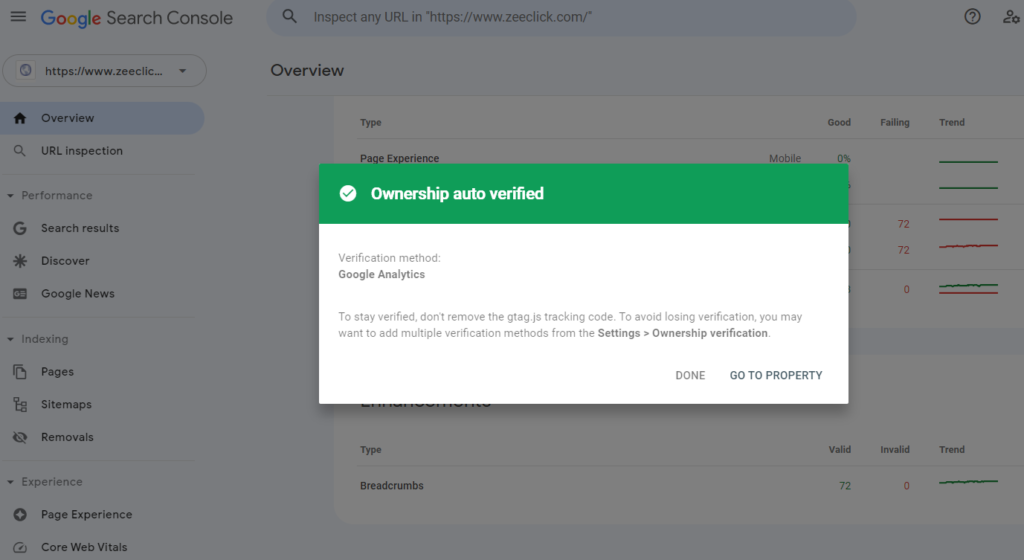
Verification:
Google demands verification as part of the setup procedure because a site’s GSC can have a lot of data and settings that you wouldn’t want unauthorized people to access. The only way to verify a domain property is to add a DNS record to your domain name provider, which is required when adding a domain property.
Check that your domain registrar is included in the drop-down menu after adding your domain (shown above). Select it to start the automated authorization procedure if it does.
The TXT record, the line of characters next to the “copy” button, must be copied to verify your domain name provider if your domain registrar isn’t listed. Google advises trying again in a few hours if the verification doesn’t work the first time because it can take some time for the modification to take effect.
Suppose you chose a URL prefix property rather than a domain property. You could also use the domain name provider method, HTML file upload, HTML tag, Google Analytics tracking code, Google Tag Manager container snippet, and more to confirm site ownership.
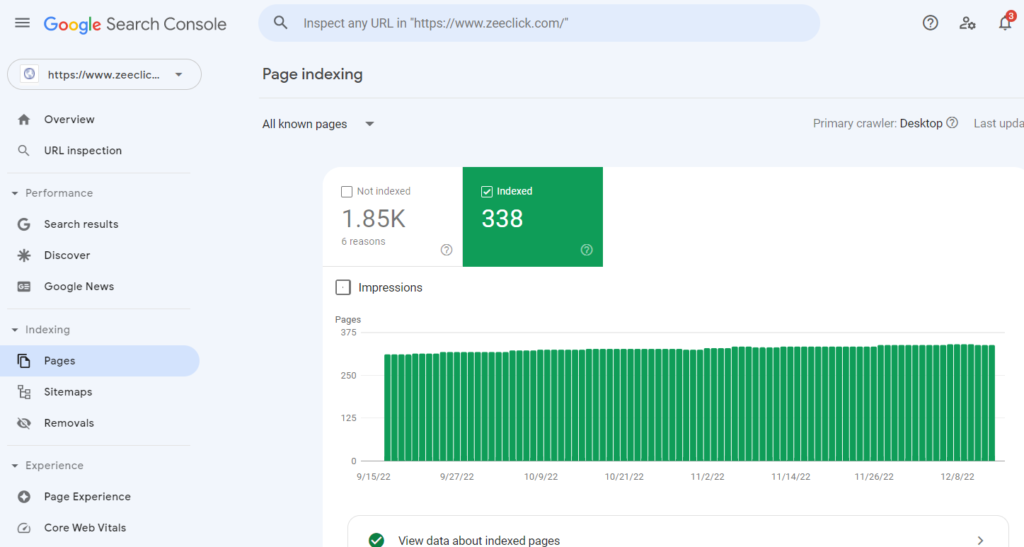 Reports for Index Coverage.
Reports for Index Coverage.
This report displays the position of the URLs on your website in Google’s index. It can resolve any technical SEO problems that might prevent your pages from appearing in search results.
Google will notify you via email if it discovers a new index coverage problem on your website, but it won’t do so if an existing problem worsens. It’s wise to periodically review this report to ensure all problems have been resolved.
Toggling the “error,” “valid with warnings,” “valid,” and “excluded” options will cause the chart to be refreshed so that the desired data is displayed, much like in the Performance report. Here are the meanings of each of those choices.
The page is not indexed and does not appear in Google search results, which is an error. You can find the URLs that the problem pertains to by clicking on a specific error (in the table below the chart), which can lead you to a solution.
Suitable with cautions:
These pages have been indexed; however, they might not appear in Google search results. GSC uses this label because it believes you should be aware of a concern.
Valid: This shows that a page has been indexed by Google and appears in search results; no further action is required (unless you don’t want the page to be indexed).
Omitted:
Because Google believes it is your purpose to exclude certain pages, these pages are not indexed and not marked as having an error. This may occur, for instance, when a page has a noindex directive or when another page has a canonical tag.
Your indexed pages should be increasing if you’re consistently adding new material. If you’re merging or getting rid of content that is no longer useful, you might see that they are trending down. There may be a problem preventing Google from indexing your content if there is a rapid drop in the number of indexed pages (that isn’t justified by something you did, like merging content).
Reports on enhancements:
These reports display trends for errors, valid pages with errors, and valid pages, much like the Index Coverage report. Google search results don’t display pages with problems. Pages with faults may not display in locations where they would normally be eligible to do so, such as the Top Stories carousel for AMP pages, for example, although they can still be seen in search results.
You’ll find the AMP status report in the Enhancements area of your GSC if you’re using AMP (Accelerated Mobile Pages), Google’s framework created to make pages faster for users of mobile devices by serving them via its cache.
A side note: AMP’s main selling point was its ability to show up in the Top Stories carousel. When the page experience update launches, Google will also remove this restriction, allowing pages that do well on page experience to show up in this highly sought-after search feature.
Structured data syntax mistakes are collected in the unparsable structured data report. Because the faults can be preventing Google from classifying the feature type, they are covered in this report rather than the report for the specific feature (like an event or job-rich results, for example).
Using Google Search Console to troubleshoot
——————————
You already have access to a large amount of the information you’ll need to fix indexing problems in the Index Coverage and Enhancements reports. GSC also provides the URL inspection tool, and manual actions report to assist you in resolving issues that can prevent your pages from appearing in Google searches.
The tool for inspecting URLs. You can use this feature to get details about the Google-indexed version of a specific page. It’s especially helpful because it collects all of a page’s errors in one location.
A page’s current index state, AMP or structured data issues, and more are all visible. The top-right corner of the page also has a “test live URL” button that you can use to check if the page can be indexed. This button is particularly helpful for checking whether problems persist after you’ve applied a remedy.
If you wish Google to reindex your page, you can use the tool to request indexing (although indexing is not guaranteed). This is also helpful after you’ve corrected errors or made significant page adjustments.
The report on manual actions:
When one of Google’s human reviewers concludes that a page or pages on a site do not adhere to the company’s webmaster quality requirements, manual steps are taken by Google. Hidden text, taking part in link schemes, and misusing structured data are a few examples of these infractions. A manual action can have a variety of effects, from worse ranks for certain pages to the exclusion of the entire site from search results.
If Google takes manual action against your site, you’ll get an email about it. Any manual actions are also displayed in the GSC’s main overview part and can be accessed from the manual actions section (located in the left-hand navigation panel).
To examine a sample of the impacted pages and read a description of the detected issue, click on it. There is a link in the description that will teach you how to fix that specific manual operation. Once all of the problems have been resolved, you may click the “request review” option to ask Google to evaluate your website. This procedure can take a few days to a week, and Google will provide you with email updates on the review’s status.
Dimensions of Performance Reports
——————————
Several of the so-called Dimensions of a website’s performance statistics are visible by scrolling down to the second section of the Performance page.
Six dimensions exist:
- Queries: Displays the most popular search terms along with the number of clicks and impressions connected to each keyword combination.
- Pages:Displays the most effective web pages (plus clicks and impressions).
- Countries: Leading nations (plus clicks and impressions).
- Devices:Displays the most popular tablet, desktop, and mobile devices.
- Search Appearance: This displays the various rich results types in which the website was shown. Additionally, it indicates whether Google used Web Light results or video results to display the website, along with the related click-through and impression data. Results that are optimized for extremely sluggish devices are known as Web Light results.
- Dates: The dates tab groups the impressions and clicks by date. It is possible to sort the clicks and impressions in either descending or ascending order.
Keywords
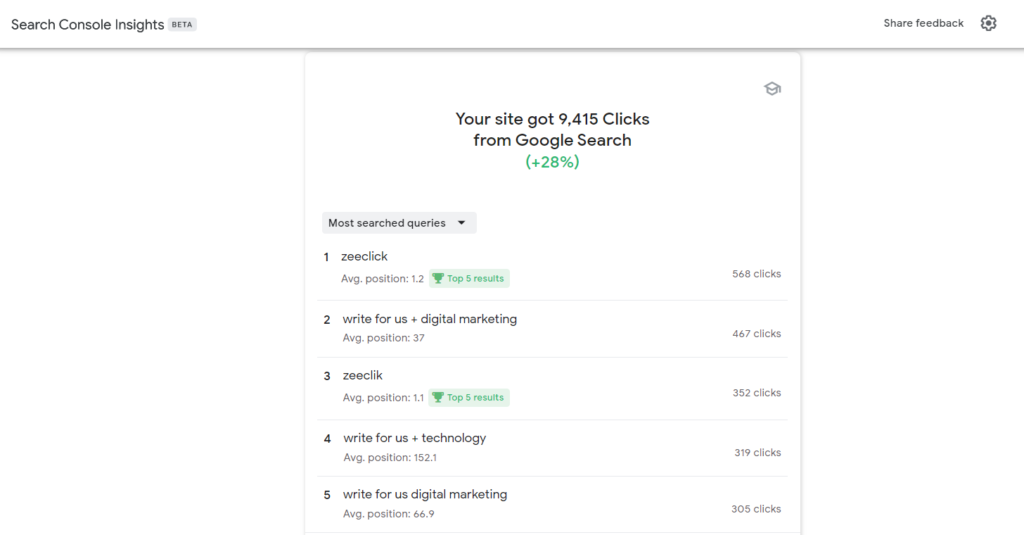 The keywords are one of the dimensions of the Performance Report that are shown in the Queries (as noted above). The top 1,000 search terms that led to traffic are displayed in the searches report.
The keywords are one of the dimensions of the Performance Report that are shown in the Queries (as noted above). The top 1,000 search terms that led to traffic are displayed in the searches report.
The underperforming questions are of particular importance.
Some of those queries show low traffic volumes because they are uncommon; this type of traffic is referred to as long-tail traffic.
However, some search requests come from websites that may need to be improved, may require additional internal links, or may indicate that the keyword phrase needs to have its own webpage.
Reviewing the underperforming keywords is usually a good idea because some of them might be fast fixes that, when the problem is fixed, might result in a large boost in traffic.

